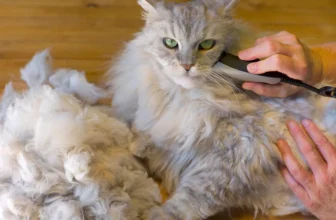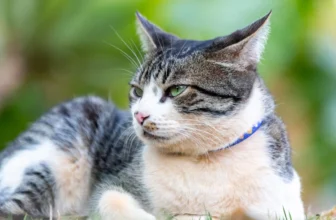As a proud American Wirehair owner, you want your feline friend to look and feel their best at all times. A big part of achieving that goal is keeping their claws trimmed, but it’s easier said than done. You may be wondering, “how do I trim my American Wirehair’s claws without causing any discomfort or pain?” This step-by-step guide will walk you through the process from start to finish, all while offering tips, tricks, and alternatives for making claw trims easier. Whether you’re a first-time pet parent or a seasoned pro, this article has everything you need to know to keep your American Wirehair healthy, happy, and scratch-free.
Why Should You Trim Your Cat’s Claws?
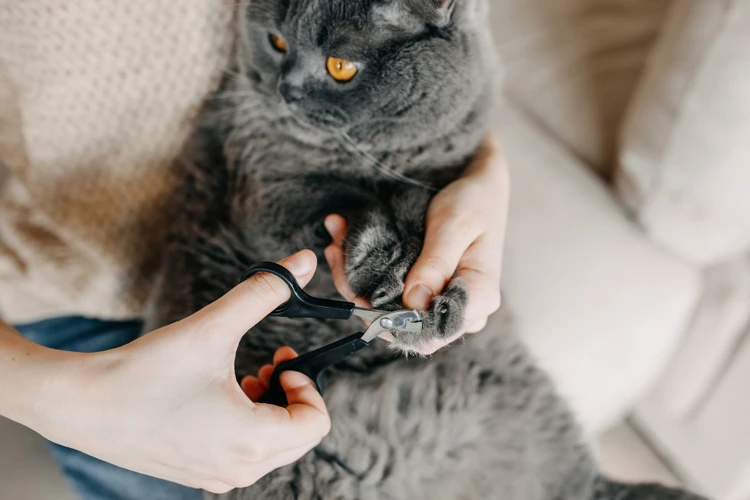
Keeping your American Wirehair’s claws trimmed is an important part of their overall grooming routine. It serves both practical and health reasons for your feline friend. In this section, we will discuss why it is important to trim your cat’s claws regularly. This is just as vital as other grooming practices such as brushing, bathing, and cleaning their ears. By trimming your cat’s claws regularly, you will help them stay healthy, happy, and comfortable. Let’s take a closer look at why this grooming practice is so important for your furry friend.
For more information about American Wirehair grooming, check out our wirehair grooming tools article.
Reduce Scratching Damage
Regularly trimming your American Wirehair’s claws can significantly reduce scratching damage to your furniture and other household items. Sharp claws can easily tear apart your sofa, drapes, and even walls. By keeping your cat’s claws trimmed, you can protect your home furnishings and preserve their longevity. Additionally, it will reduce the risk of accidents that may occur due to your wirehair’s sharp claws, like slipping from high surfaces.
To protect your furniture, consider investing in a sturdy scratching post. Having a designated area for scratching will encourage your pet to scratch there instead of your furniture. Also, the post will help your Wirehair to stretch properly.
However, if your cat is already scratching your furniture, regular claw trims might not be enough. In such cases, it is a good idea to train your cat to use a scratching post instead.
By trimming the claws, you can also ensure that your cat won’t accidentally scratch you or someone else in your household. Accidental scratches from excited or playful cats can be painful and unsightly. Trimmed claws are less likely to cause accidental scratches.
While trimming your cat’s claws, make sure to check for any signs of scratches, cuts, or other injuries. If you notice any, attend to them immediately to prevent them from worsening.
Note that you should never declaw your cat. Declawing is an extreme and painful procedure that can cause permanent damage to your cat’s paws, and can also change your cat’s natural behavior and instincts. Opting to trim your cat’s claws instead is a much safer, humane, and effective option.
To learn how to brush your American Wirehair like a pro, check out our American Wirehair Brushing Guide.
Prevent Overgrowth and Injuries
Preventing overgrowth and injuries is another important reason to trim your American Wirehair’s claws. If left untrimmed, your cat’s claws can grow too long and will be more susceptible to breaking or splitting, which can be painful and lead to infection. Overgrown claws can also become curved and grow into your cat’s paw pads, causing discomfort and limping.
Cats with long claws can inadvertently injure their owners or other pets during playtime or accidentally scratch furniture, carpets or curtains in your home. Trimming your cat’s claws can prevent these types of accidents from happening and help maintain a peaceful household.
Regular claw trims can also help you monitor your cat’s paw health. During a trim, you can take a look at the paw pads for any cuts or other issues. If you notice any problems, consult your veterinarian for advice.
Ensuring good overall hygiene is also crucial for your American Wirehair’s health. Bathing and cleaning your cat’s ears regularly can prevent infections and skin problems. Check out our articles on American Wirehair regular baths and cleaning American Wirehair ears to learn more.
Additionally, following a consistent grooming schedule that includes using the right shampoo and conditioner can help promote healthy skin and a shiny coat. Dental health is also critical and requires regular brushing and check-ups – see our article on American Wirehair dental tips for more information.
Finally, paying attention to your cat’s shedding habits and taking appropriate measures can reduce hairballs and prevent skin irritation – read our tips on how to prevent and treat hairballs in American Wirehair, and find out how to address American Wirehair skin problems if they occur.
Ensuring your American Wirehair’s overall wellbeing requires taking care of all aspects of their health, and regular claw trims are an essential part of that care.
Preparing for the Trim

Getting ready to trim your American Wirehair’s claws can seem daunting, especially if you’ve never done it before. But with a little preparation and patience, you can make the process go smoothly. Before getting started, you’ll need to gather your supplies and get your cat ready to be handled. If you need tips for managing your wirehair’s fur, check out our guide on dealing with shedding in American Wirehairs.
Gather Your Supplies
Before you start trimming your American Wirehair’s claws, it’s important to gather all the necessary supplies. This will ensure that the process goes smoothly and efficiently. Here are the essential supplies that you’ll need:
| Supplies | Description |
|---|---|
| Nail Clippers | You’ll need a good quality pair of cat nail clippers. Avoid using human nail clippers, as they are not designed for cats and may cause injury to your pet. |
| Treats | Prepare some of your cat’s favorite treats, as it will help to calm your pet and make the experience more enjoyable. |
| Towel | A small towel or blanket can be used to wrap your cat for better control during the trimming process. |
| Styptic Powder or Cornstarch | In case you accidentally cut the quick, have styptic powder or cornstarch on hand to stop the bleeding. |
| Scratching Post | After a claw trim, your cat may want to scratch something to help relieve the sensation. Make sure you have a scratching post or other appropriate surface available so that your cat can scratch comfortably. |
Make sure that you have all of these supplies within arm’s reach before you start trimming your cat’s claws. This will help you to remain calm, focused, and in control throughout the process. By creating a positive experience for your cat, you’ll be much more likely to have success with future claw trims and your pet will appreciate the effort you put forth to keep them healthy and comfortable.
Get Your Cat Ready
Before trimming your American Wirehair’s claws, it’s essential to get your furry friend ready. Here are some steps to follow to make the process easier and safer for both you and your cat:
Choose a quiet and comfortable spot where your cat can feel relaxed. Avoid areas that are too noisy or busy with other people or pets.
Have a towel or a blanket handy to wrap your cat in. This helps to keep them calm and prevents them from scratching or biting during the trimming process.
Gently pet and stroke your cat before you start trimming their claws. This helps to calm them and creates a positive association with the process.
Inspect the claws for any signs of injury or infection. If you notice any swelling, redness, or discharge, avoid trimming the claws and consult with your vet instead.
Prepare some treats or favorite toys to reward your cat during and after the trimming process. This reinforces positive behavior and helps to create a more pleasant experience for your cat.
By following these simple steps, you can ensure that your American Wirehair is comfortable and calm during the claw trimming process. This makes it easier for you to achieve the desired results without causing any unnecessary stress or harm to your pet. Remember, a happy and well-cared-for cat is a healthy and well-behaved one.
How to Trim an American Wirehair’s Claws
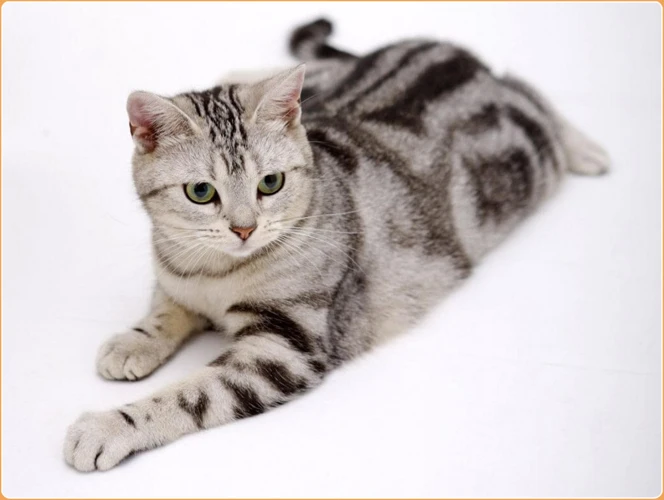
As a cat owner, trimming your American Wirehair’s claws is an essential part of their grooming routine to ensure their health and safety. While it may seem like a daunting task, with the right tools and techniques, it can be done easily and safely. In this section, we’ll guide you through the step-by-step process of trimming your American Wirehair’s claws, so you can keep your feline friend happy and healthy. Let’s get into the details!
Step 1: Restrain Your Cat
Before you begin trimming your American Wirehair’s claws, it’s important to restrain your cat properly to avoid any potential accidents. Follow these steps to ensure your cat’s safety during the process.
| Step | Description |
|---|---|
| Step 1 | Prepare a comfortable workspace. You can use a towel, blanket, or scratching post to provide stability for your cat. Make sure your cat is calm and comfortable before proceeding. Use soothing tones and gentle touches. |
| Step 2 | Hold your cat securely. You can use the scruff of their neck or hold them gently but firmly in your lap. Make sure your cat is relaxed and not struggling or attempting to flee. |
| Step 3 | Expose each paw one at a time. You can gently push on the paw pad to extend the claws. Be careful not to press too hard and cause discomfort. |
It’s crucial to approach your cat calmly and confidently during the restraint process. The more relaxed and comfortable your cat is, the easier it’ll be to trim their claws safely. Remember, if at any point during the process your cat becomes agitated or fearful, it’s best to stop and try again later.
Step 2: Examine the Claw
Before proceeding with the actual trimming process, it is important to examine each claw and look for the quick. The quick is a blood vessel that runs through your cat’s claw, and if you accidentally cut it, it can cause pain, bleeding and infection.
To begin examining the claw, it’s best to have your cat in a comfortable and calm position. You can hold your cat’s paw gently, but firmly, so that they are unable to move and inspect the claw thoroughly.
Firstly, locate the claw’s clear outer shell and gently separate it from the fur using a cat claw clipper. The clear shell protects the quick so that it doesn’t get damaged when your cat scratches. So, you should only cut below the clear shell.
Then, look for the quick, a small pink area located just below the clear shell. In some cats, the quick may be easy to see, while in others, it may be more difficult to spot. Be extra cautious and go slowly if your cat has dark claws, as the quick will be less visible.
To avoid cutting the quick, only trim a small amount of the claw at a time. You should be able to see the pink quick after cutting off a small piece of the claw. If you still cannot see it, avoid cutting any further and move on to another claw.
Use the following table as a summary of what to do in this step:
| Step 2: Examine the Claw |
|---|
| Hold your cat’s paw gently but firmly |
| Locate the claw’s clear outer shell and separate it from the fur |
| Look for the pink quick that should be visible through the clear shell |
| Cut very slowly in small sections, being careful not to snip the quick |
Taking the time to examine each claw before trimming will help ensure your American Wirehair cat remains comfortable and safe throughout the process.
Step 3: Cut the Claw
Now that you have examined the claw and found the appropriate trimming location, it’s time to cut the claw. It’s important to use the correct technique to avoid causing pain or injury to your American Wirehair.
Step 1: Hold the clippers in your dominant hand and grasp your cat’s paw with your other hand, gently pressing the pad to extend the claw.
Step 2: Position the clippers just below the quick, avoiding any pink areas that indicate the presence of blood vessels and nerves. Slowly squeeze the clippers to make a clean, even cut. Avoid cutting at a slant.
Step 3: Once you have cut the claw, examine the tip to ensure a clean, straight cut. If it looks jagged, use a nail file to smooth it out.
Step 4: Move on to the next claw, repeating the process for each one.
It’s important to take your time when cutting your cat’s claws and to never rush the process. If your cat becomes agitated or upset, take a break and try again later. Remember to give your cat plenty of praise and treats to reward them for their cooperation.
By following these steps and using proper technique, you can make the claw trimming process painless and stress-free for both you and your American Wirehair.
Step 4: Check for the Quick
After you’ve successfully trimmed your American Wirehair’s claw, the next step is to check for the quick. This is the pink part of the claw that contains blood vessels and nerves. Trimming the quick can be painful for your cat and lead to bleeding, so it’s essential to make sure you don’t cut it.
To check for the quick, follow these steps:
- Look for the pink part: Before checking the claw for the quick, make sure your cat is calm and relaxed. Hold the claw firmly and look at it closely. The quick is visible as a pinkish line running vertically through the claw.
- Estimate the distance: Once you have located the quick, estimate how far it is from the tip of the claw. Make sure you leave a safe distance between the quick and the cutting point to avoid injuring your cat.
- Trim: Use your cat claw trimmers to trim the claw at a safe distance from the quick. Avoid cutting too short, as this can cause pain and bleeding. Apply gentle pressure to the paw to encourage any bleeding to stop if you accidentally cut the quick.
It’s important to note that the location of the quick may vary from claw to claw and cat to cat, so it’s crucial to be mindful and take care when trimming.
If you’re unsure or uncomfortable with checking for the quick or trimming your cat’s claws, consider reaching out to a professional groomer or veterinarian for assistance. It’s always better to be cautious and take the necessary precautions to keep your furry friend safe and healthy.
What to Do if You Cut the Quick

Sometimes, despite our best efforts, we may accidentally cut the “quick” of our American Wirehair’s claw. The quick is a vein that runs through the claw and can bleed significantly if cut. If you do happen to nick the quick, don’t panic! There are a few steps you can take to stop the bleeding and prevent infection.
Step 1: Stay Calm
If you do accidentally cut your cat’s quick, it’s important to stay calm. Your cat may become alarmed if they see you panicking, and this could cause them to struggle and exacerbate the injury. Take a deep breath and remain calm.
Step 2: Apply Pressure
Using a clean cloth or paper towel, apply gentle pressure to the affected claw for several minutes. This will help to stop the bleeding. If the bleeding does not subside, try applying a small amount of corn starch or styptic powder to the affected area.
Step 3: Clean the Wound
Once the bleeding has stopped, clean the wound with a mild antiseptic wash. You can use hydrogen peroxide or rubbing alcohol for this purpose. Gently pat the wound dry with a clean towel.
Step 4: Monitor for Infection
Keep an eye on the affected claw over the next few days to monitor for any signs of infection. If you notice redness, swelling, or discharge, or if your cat is showing signs of pain or discomfort, it’s important to seek veterinary care promptly.
Step 5: Offer TLC
After a traumatic experience like this, your cat may be feeling stressed or anxious. Offer extra TLC, such as gentle petting and reassuring words, to help them feel calm and comforted.
Remember, accidents happen. While it’s important to take precautions when trimming your American Wirehair’s claws, it’s equally important to know what to do in the event of an injury. By staying calm, applying pressure, cleaning the wound, monitoring for infection, and offering TLC, you can provide your cat with the care they need in the event of a nail trimming mishap.
Alternatives to Trimming Your Cat’s Claws
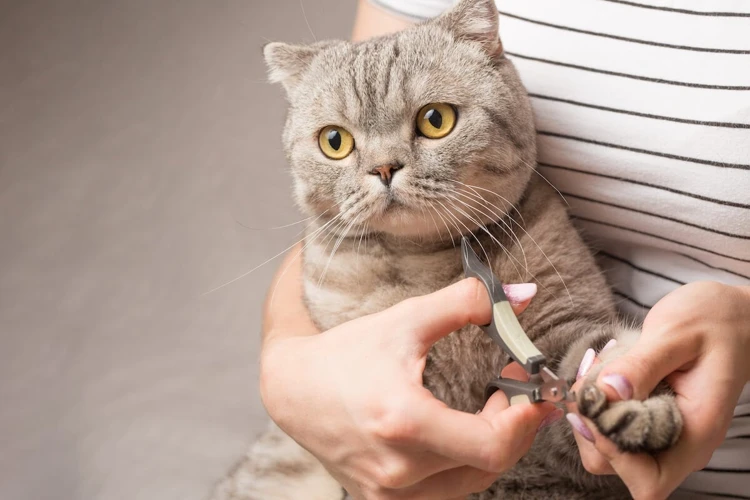
If you’re hesitant to trim your American Wirehair’s claws or your cat simply won’t tolerate it, there are a few alternatives you can consider. One option is applying nail caps, which are small plastic covers that fit over each claw. They need to be replaced every 4-6 weeks, but they are effective at preventing scratching damage to furniture and other household items.
Another option is scratching posts and pads. American Wirehairs are naturally inclined to scratch to help remove the outer layer of their claws and provide exercise. Providing an appropriate scratching surface may help redirect their scratching behavior away from furniture. Make sure the post or pad is tall enough for your cat to stretch and sturdy enough not to wobble.
You can also try using anti-scratch sprays that contain unpleasant scents, such as citrus or bitter apple. These sprays can be applied to furniture and other household items and may discourage your cat from scratching in the area.
Lastly, providing enrichment for your cat may decrease their desire to scratch. Interactive toys, hiding treats and puzzle feeders, and spending quality playtime with your American Wirehair can help keep them mentally stimulated and tired, reducing excess energy that may be directed towards scratching.
Remember, it’s important to choose alternatives that fit your cat’s personality and behavior. While trimming claws may not be the best option for every cat, there are several alternatives available to help keep your American Wirehair’s claws under control.
Tips for Making Claw Trims Easier
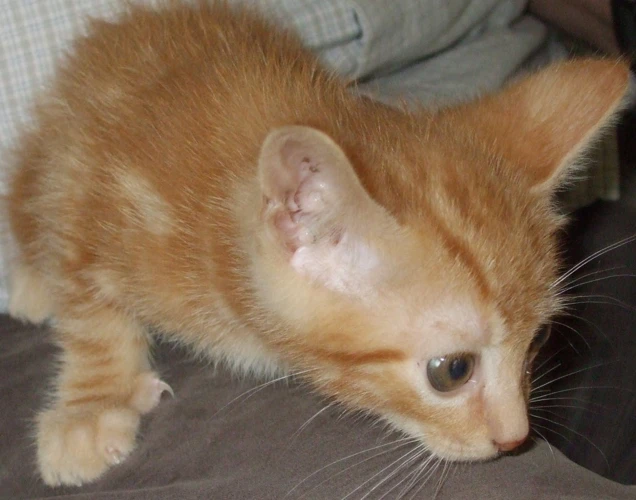
Keeping your American Wirehair’s claws trimmed is a necessary part of owning a cat, but it can be a challenging task. Fortunately, there are some tips and tricks that you can use to make the process easier for both you and your cat. By employing these strategies, you can help ensure that nail trims are less of a chore and more of a bonding experience with your feline friend. Let’s take a look at some effective ways to make claw trims less stressful for everyone involved.
Start Young
One of the best ways to make trimming your American Wirehair’s claws easier is to start when they are young. It is recommended that you start socializing your cat with paw handling as early as 2-3 months old so that they become accustomed to it and see it as a normal part of their life. This way, when it’s time to trim their claws, they won’t resist or become scared.
To start young, you can make paw handling part of your daily routine. Spend a few minutes every day touching and holding your kitten’s paws, gently massaging them, and pressing on their paw pads (this will help get them used to the feeling of the clippers later on). You can also offer treats or play with your kitten during this time to make it a positive experience.
As your kitten gets older, gradually introduce them to the clippers. Start by letting them sniff the clippers and get used to their scent. Next, touch the clippers to their paws (without actually cutting any claws) to help them become desensitized to the sensation. You can gradually work up to actually clipping their claws as they become more comfortable.
By starting young and making paw handling a regular part of your routine, your American Wirehair will be much more receptive to having their claws trimmed as they get older. This will save you both stress and anxiety, and make for a more enjoyable grooming experience.
Take it Slow
When it comes to trimming your American Wirehair’s claws, taking it slow is crucial for a successful session. Rushing the process can cause anxiety and stress for both you and your cat. Here are some tips for taking it slow:
| Tip | Description |
|---|---|
| Start with short sessions | Begin with one or two claws at a time, and gradually increase the number as your cat becomes more comfortable. Don’t try to trim all of your cat’s claws at once. |
| Take breaks | If your cat becomes agitated or stressed, take a break. Let your cat relax and calm down before continuing the session. |
| Be patient | Don’t rush the process. If your cat is resistant or anxious, take a step back and try again later. Remember, this is a gradual process that takes time and patience. |
| Be gentle | Handle your cat’s paws and claws with care. Use a gentle touch and avoid placing too much pressure on your cat’s toes. |
Following these tips can help make claw trimming sessions more comfortable and stress-free for both you and your American Wirehair. Remember to take your time and be patient, and always reward your cat with treats and positive reinforcement for good behavior. This will make future claw trims easier and more successful.
Offer Treats and Positive Reinforcement
When it comes to trimming your American Wirehair’s claws, offering treats and positive reinforcement can make the process much smoother for both you and your cat. This is especially important if your cat is easily stressed or becomes anxious during grooming.
Treats:
Before you begin trimming your cat’s claws, gather their favorite treats. These treats can be used as a distraction during the trimming process. For example, you can offer your cat a treat while you examine their claw, and another treat when you finish trimming it. This will help your cat associate the trimming process with positive experiences.
Positive reinforcement:
In addition to treats, positive reinforcement can also be used to make the trimming process less stressful for your cat. Every time your cat allows you to trim one of their claws, offer praise and affection. This can be in the form of verbal praise (such as saying “good job!”) and pets or snuggles. Positive reinforcement can help reinforce good behavior and encourage your cat to be calm during the trimming process.
Table of tips:
| Tips for offering treats and positive reinforcement: |
|---|
| 1. Use your cat’s favorite treats as a distraction |
| 2. Offer treats during and after the trimming process |
| 3. Use positive reinforcement, such as verbal praise and pets or snuggles |
| 4. Be patient and take breaks if needed |
Remember to be patient and take breaks if your cat becomes stressed. With time and practice, offering treats and positive reinforcement can help make trimming your American Wirehair’s claws a stress-free process for both you and your furry friend.
When to See a Vet
Although trimming your American Wirehair’s claws can be a routine activity, there are instances when you should take your cat to a vet for their safety and well-being. Keeping an eye out for these signs will help you determine if your pet needs professional veterinary attention.
1. Excessive bleeding: While a small amount of bleeding is normal when cutting your cat’s claws, if the bleeding seems excessive, it can indicate a deeper issue that may require veterinary attention. Applying pressure to the area and using styptic powder can help control the bleeding, but a vet should be visited if it continues.
2. Reluctance to use their claws: If your cat is reluctant to use their claws or seems to be in pain when they do so, it is a sign that something could be wrong. This reluctance to use their claws could be due to a wide range of issues, from ingrown nails to infections, tumors, or other underlying health issues. A vet visit can help determine the underlying cause and inform the appropriate treatment plan.
3. Cracked or broken claws: Cracked or broken claws are painful and can easily become infected, leading to much bigger complications down the line. If your cat has a broken claw, you should take them to the vet to have it treated to prevent further problems.
4. Overgrown claws: Overgrown claws are not only uncomfortable and awkward for your cat, but they may also cause injury to both your pet and your furniture. While this is a problem that can be rectified through claw trimming, cats with rapidly growing claws may require veterinary attention.
5. Changes in behavior: Finally, if your cat is acting differently than normal, exhibiting signs of discomfort or lethargy, or showing less interest in play or interacting with you and their environment, consider seeking veterinary attention. These behavioral changes can signal underlying health issues such as arthritis, infections, or other painful conditions that interfere with their natural daily activities.
If you are ever in doubt regarding your cat’s health, don’t hesitate to reach out to a veterinarian. Sometimes, even subtle changes in your pet’s habits can indicate something more serious, and early treatment can make all the difference. Your vet can conduct a thorough examination and provide you with customized advice tailored to your cat’s health status.
Conclusion
In conclusion, trimming your American Wirehair’s claws is an important aspect of their overall health and wellbeing. By reducing scratching damage and preventing overgrowth and injuries, you can keep your cat comfortable and safe at all times. However, it is important to prepare properly and approach the task with care, as cutting the quick can be painful and lead to bleeding.
Remember to gather all necessary supplies and prepare your cat for the trim before beginning. Take your time and be gentle when restraining your cat and examining their claws. If you do accidentally cut the quick, stay calm, use a styptic powder or cornstarch to stop the bleeding, and offer your cat comfort until the bleeding stops.
If trimming your cat’s claws proves too difficult or stressful, there are alternatives such as scratching posts or nail caps that can offer similar benefits without the need for trimming. And always remember to offer your cat treats and positive reinforcement to make the experience as comfortable as possible.
Additionally, it’s important to know when to seek professional veterinary help. If you notice any signs of infection or your cat is experiencing pain or discomfort after the trim, consult with your vet. It’s always better to be safe than sorry when it comes to your beloved pet’s health.
Overall, trimming your American Wirehair’s claws can be a simple and effective way to keep them happy and healthy. By following the proper steps and taking the necessary precautions, you can make the process as stress-free as possible for both you and your furry friend.
Frequently Asked Questions
1. Can I use regular nail clippers on my American Wirehair?
Using regular nail clippers can create pressure and damage to the claw. It is recommended to use clippers specifically designed for cats.
2. How often should I trim my cat’s claws?
Trimming frequency depends on your cat’s activity level and claw growth rate. Generally, once every two to three weeks is recommended.
3. What should I do if my cat is afraid of nail trims?
Try to associate positive experiences with nail trims by offering treats and starting with short sessions. If your cat is still fearful, consult with your veterinarian for possible solutions.
4. Is it safe to trim my cat’s claws at home?
When done correctly, trimming your cat’s claws at home is safe. However, it is important to know what to do if you accidentally cut the quick or if your cat becomes agitated.
5. Can I declaw my American Wirehair instead of trimming its claws?
Declawing is a surgical procedure that involves amputating the cat’s toes. It is considered a last resort and is not recommended unless there is a medical reason. Trimming your cat’s claws is a much safer and humane alternative.
6. Do I need to clean my cat’s claws before trimming?
It is not necessary to clean your cat’s claws before trimming. However, if your cat has excess dirt or debris under its claws, it may be beneficial to clean them first to avoid contamination of the clipper.
7. What if my cat has black claws and I can’t see the quick?
It is important to be extra cautious when trimming black claws. Take small cuts and check the claw after each cut to ensure you do not accidentally cut the quick.
8. What happens if I accidentally cut the quick?
If you accidentally cut the quick, your cat may experience pain and bleeding. Apply pressure to the claw with a clean cloth or tissue. If bleeding does not stop within a few minutes, consult with your veterinarian.
9. Can trimming my cat’s claws prevent furniture damage?
Trimming your cat’s claws can help reduce damage to furniture, but it is important to provide alternative scratching surfaces and discourage inappropriate scratching behavior.
10. Can I train my cat to enjoy nail trims?
Yes, you can train your cat to enjoy nail trims by making it a positive experience with treats and praise. Start slowly and gradually increase the length of each session.





